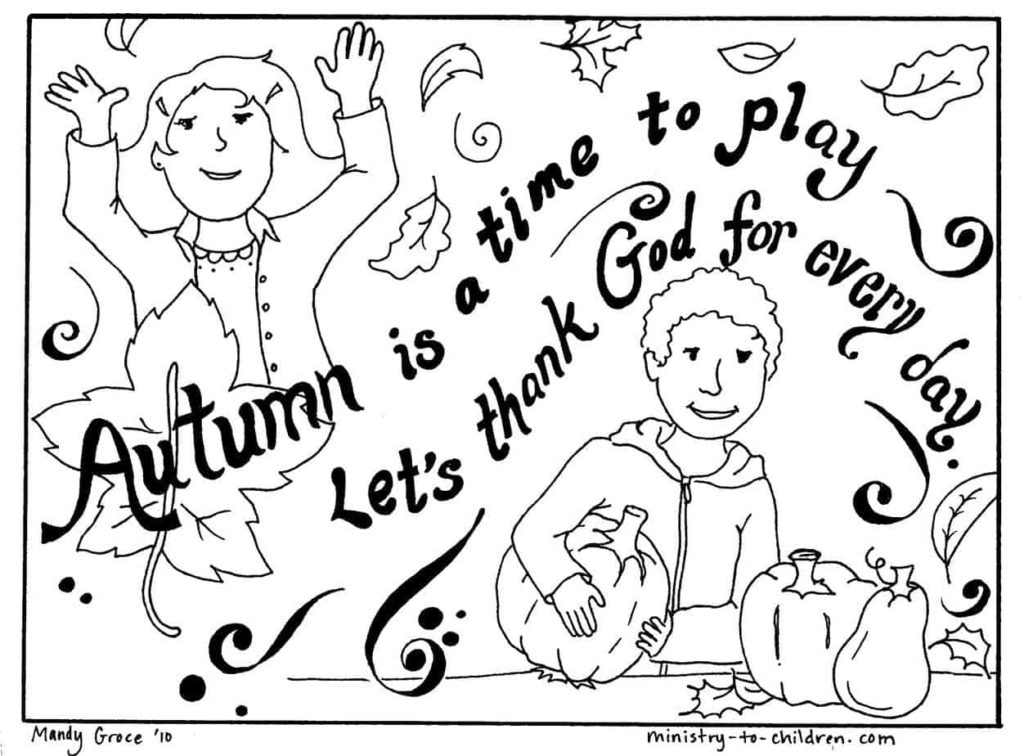For a lot of people, transitioning seasons are marked by holidays, wardrobe changes, and new flavors at Starbucks. Fall might mean a chill in the air, brilliant leaf colors, and pumpkin spice in everything from cereal to pickles. Autumn is of course a lot more than early nightfall and candy corn, though. In fact, it’s a great season to share some important Biblical principles with children. We can honor the joy of changing life patterns, as well as the wonder of harvest time. With the blessings of modern conveniences, we have the ability to live and work and thrive regardless of weather or harvest conditions, at least for the most part. But looking back at the meaning of harvest is a beautiful way to recognize how God continuously provides for us, and how He has designated times and seasons for specific purposes.
Fall Bible Lesson focus: This lesson uses the season of autumn to describe to children the wonder and beauty of varying times in the calendar, weather, and church year. We will look at God’s designation of seasons, as well as how the harvest demonstrates His care for us. This lesson also reminds kids of the importance of reaching out to others and serving God, no matter what season it is.
Scripture Passage: Varied passages featured (depending on your choice of emphasis)
Target Audience: Children Kindergarten-6th grade (children’s church, Sunday School, or Kids church)
Materials Needed: Foam or fabric leaves, candy corn, paper, paper bags, glue, markers, scissors, corn, egg carton, google eyes, tissue, seed packets, Bible (optional materials, depending on crafts and activities of choice).
The PDF version of our Thanksgiving Coloring pages is included in the lesson plan download above. See our Kids Bible Lessons website for more Autumn themed Sunday School Lessons

Games and Lesson Introduction
Lesson Opening: This lesson celebrates changing seasons, harvest, and fall. There are multiple options you might want to pursue in such a lesson. Enjoy these fall object lessons for children’s church.
Here are some activities to get kids thinking about Fall and Harvest Blessings …(select the best ones for your audience and age group):
- Leaf-blowing competition: using plastic straws, “race” foam or paper leaves across a surface to see who can power their leaves through the quickest.
- Pumpkin “bowling”: Use real or fake pumpkins, rolled down an “alley” of some sort, and attempt to knock over plastic bottles or small cans.
- Candy corn toss: Space students a few feet apart in pairs. Have one student hold a plastic bucket, and let the other student toss small candy bars or candy corn into the bucket. Step closer together or farther apart to adjust the difficulty.
- Catch falling “leaves”: stand on a chair or small ladder, and toss handfuls of fake leaves into the air. Provide kids with buckets or bags to collect as many leaves as possible within a given time frame.
- Popcorn harvest relay: Split students into two main groups. Have one child at a time from each team walk across the room, scoop up a cup full of popcorn, and return to their team to fill a bowl or bucket. See which team fills the bucket fastest, or which bucket has more popcorn at the end of a time limit.
Discuss with students how changes in season can provide us with a beautiful reminder of God’s consistency. Nothing in life stays the same forever, and yet we see patterns and cycles that repeat on a regular basis. God is making all of these things happen. He makes the planets spin and the weather change, and we can trust His goodness throughout all of it. He is a powerful, amazing, yet loving and creative God. We can celebrate how He provides for and blesses us by giving the seasons, harvest, and sunshine.
Ask: What do you like about the season of autumn? Do you know what a “harvest” is?
Fall Bible Lesson: A Season for Everything
Bible Lesson: There are a few angles you could take to hone in on Biblical principles for this topic. One potential emphasis for a fall celebration could be the way in which God orchestrates the seasons. He arranges a specific time for all things, and we can take joy and comfort in knowing that He is always in control.
While the earth remains, seedtime and harvest, cold and heat, summer and winter, day and night, shall not cease.” -Genesis 8:22
For everything there is a season, and a time for every matter under heaven:
2 a time to be born, and a time to die;
a time to plant, and a time to pluck up what is planted…
9 What gain has the worker from his toil? 10 I have seen the business that God has given to the children of man to be busy with. 11 He has made everything beautiful in its time. Also, he has put eternity into man’s heart, yet so that he cannot find out what God has done from the beginning to the end. 12 I perceived that there is nothing better for them than to be joyful and to do good as long as they live; 13 also that everyone should eat and drink and take pleasure in all his toil—this is God’s gift to man. 14 I perceived that whatever God does endures forever; nothing can be added to it, nor anything taken from it. God has done it, so that people fear before him. 15 That which is, already has been; that which is to be, already has been; and God seeks what has been driven away.
-Ecclesiastes 3:1-2, 9-15
Explain to students that the context for the Genesis verse takes place right after the story of Noah, when God destroyed almost everyone and everything with the flood. This verse reminds us that He has promised never to do that again. There will always be seasons for as long as time remains. Sometimes the weather causes damage, and can be frightening. But we know God is still in control. The Ecclesiastes passage reminds us that God made all things, and sets designated seasons for our lives. The best thing we can do is to live one day at a time, recognizing that all things come from and belong to God, and rejoicing in the work that we do.
Ask: How can doing work bring us joy and pleasure? Do you like to have a routine, or prefer things to just sort of happen at random?
The next passages refer to instructions for the harvest. In the Old Testament, specific rules were set regarding collection of food and the passing of time. Here, some of those are described:
“These are the appointed feasts of the Lord, the holy convocations, which you shall proclaim at the time appointed for them. 5 In the first month, on the fourteenth day of the month at twilight,[a] is the Lord’s Passover. 6 And on the fifteenth day of the same month is the Feast of Unleavened Bread to the Lord; for seven days you shall eat unleavened bread. 7 On the first day you shall have a holy convocation; you shall not do any ordinary work. 8 But you shall present a food offering to the Lord for seven days. On the seventh day is a holy convocation; you shall not do any ordinary work.” -Leviticus 23:1-8
“And when you reap the harvest of your land, you shall not reap your field right up to its edge, nor shall you gather the gleanings after your harvest. You shall leave them for the poor and for the sojourner: I am the Lord your God.” -Leviticus 23:22
In Old Testament times (and throughout much of history), life patterns were based on the cycles of farming. People planted, the harvest of plants came in (hopefully), and people picked it to have food. Discuss how God set in place special rules that governed how people were supposed to plant and reap their crops. Some of the harvest was meant to go back to God. Additionally, provisions were made for poor people to be able to gather food and be taken care of. God also instituted holidays, so that the people could have times of rest.
Ask: What kinds of celebrations and seasonal patterns do we follow today? Do you think people really take a “sabbath” of no work, or do we tend to work all the time now?
The final element to review in this seasonal exploration is how Jesus described evangelism as a harvest. Of course, we aren’t going to pluck people like grain or corn, but we can recognize that there are people who need to hear the Gospel and be brought into God’s family. We can grow “fruits of the spirit” and celebrate a harvest of believers when we share the love of Christ with those in need.
And Jesus went throughout all the cities and villages, teaching in their synagogues and proclaiming the gospel of the kingdom and healing every disease and every affliction. 36 When he saw the crowds, he had compassion for them, because they were harassed and helpless, like sheep without a shepherd. 37 Then he said to his disciples, “The harvest is plentiful, but the laborers are few; 38 therefore pray earnestly to the Lord of the harvest to send out laborers into his harvest.”
-Matthew 9:35-38
Explain to students what this might mean. There are many people that need to know God loves them. A lot of people around the world, and in our own backyards, are sad and suffering. God has granted us the opportunity to share His love with them. Sometimes that means telling people about Jesus or inviting them to church. Sometimes it just means caring about them, talking with them, and demonstrating what it means to serve and offer kindness to others. We can be “harvest laborers” when we seek to help people around us.
Finally, end the lesson with a joyful seasonal shout from the Psalms:
Let the heavens be glad, and let the earth rejoice;
let the sea roar, and all that fills it;
12 let the field exult, and everything in it!
Then shall all the trees of the forest sing for joy
13 before the Lord, for he comes,
for he comes to judge the earth.
He will judge the world in righteousness,
and the peoples in his faithfulness. -Psalm 96:11-13
Ask: How will the trees sing? What might be meant by these verses?
Explain that God has made everything in the world. When we see beauty in creation, it’s like those things are praising God and glorifying Him, just by doing what He put them on Earth to do. We can praise God with our lives when we remember that He made us and loves us. No matter what season it happens to be, whether we are laboring or resting or celebrating or sobbing, we can live in His presence and give thanks to Him for all that He provides.
Close this harvest Sunday School lesson with a simple prayer thanking God for the blessings of the Fall season. Ask for help in enjoying and appreciating each time of year we experience, as well as help in realizing a spiritual “harvest.”
Crafts: There are so many fun fall crafts to enjoy as we celebrate the season! Here are a few suggestions (full descriptions available):
- Candy Corn collage
- Leaf bracelet or decoration
- “Pumpkin Pouch” stuffed bag
- Paper strip pumpkin

I praise God for you. I praise God that he used you to make a curriculum for our dear precious children you said suffer, he said suffer. The children to come unto Him and so with this curriculum, I am so excited to go in and teach the word of God to our precious ones thank you.